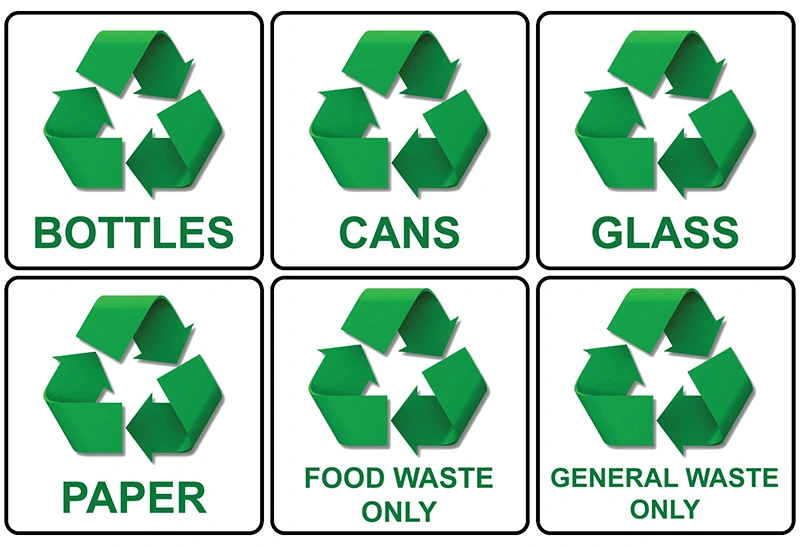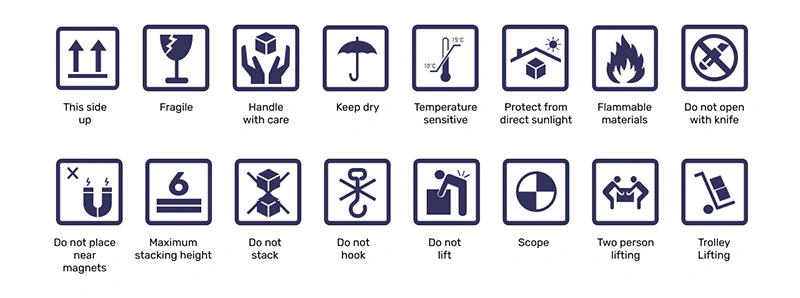With over 10 years of experience in packaging, this guide will help you understand common packaging symbol types, compliance requirements, and proper usage, helping you avoid these risks and improve shipping efficiency.

This article will answer your questions:
- What are packaging symbols and why do they matter?
- Which packaging symbols are required for export?
- How to use fragile, storage and other handling symbols correctly
- How to choose and print eco friendly recycling symbols
- How to avoid incorrect packaging symbols
What are packaging symbols and why it matters?
They transcend language barriers, helping customs officials, courier operators, terminal operators, and warehouse managers quickly understand how packaging should be handled.

Common packaging symbol types
| Symbol Category | Standard/Specification | Common Examples | Practical Significance for You |
|---|---|---|---|
| Transport & Storage | ISO 780 | Fragile, This Way Up, Keep Dry | Reduce transport damage rate and minimize claims |
| Compliance Certification | CE, FCC, etc. | CE Mark, UKCA Mark | Ensure smooth customs clearance and avoid returns due to compliance failure |
| Environmental & Recycling | ISO 14021 | Recyclable Symbol, Green Dot | Meet environmental regulations and enhance brand image |
| Food Safety | ISO 22000 | Food Contact Mark, Halal Mark | Comply with food export requirements and avoid market complaints |
| Hazardous Goods & Chemicals | GHS, UN RTDG | Flammable, Corrosive, Toxic Signs | Compliant transportation and reduced safety risks |
- Export to EU: The CE mark is mandatory and needs to be placed in a visible area, printed clearly and without deformation.
- Printing on kraft corrugated paper: Line thickness ≥5mm to avoid blurring due to wear and tear during transportation.
- Waterproof requirements: It is recommended to use waterproof ink or laminated labels for sea freight packaging, and the symbols can last for more than 60 days.
Which packaging symbols are mandatory for overseas shipping?
Mandatory requirements vary between countries and markets, but most international shipments require the following symbols:

- Shipping direction and fragile marking: Simply mark these words: This Way Up, Fragile.
- Moisture-proof sign: Marked with the words “Keep Dry”, sometimes accompanied by a moisture-proof graphic symbol.
- Stacking Limit is a mark that clearly limits the height or weight of a package.
- Dangerous goods identification such as UN3480, ensuring compliance with IMDG standards.
- Regulatory compliance markings (e.g. CE, FCC, UKCA)
- Transport identification (marking box number, cargo name, quantity, weight and other basic information)
What recycling and eco-friendly symbols require?
- Mobius Loop / printable recycle symbol
- Green Dot symbol – proof that some EU countries charge for packaging recycling
- Resin identification code (plastic packaging)
- Compostable
Practical advice: Place the recycling symbol on the bottom or side of the packaging when designing, and the color should be clear and eye-catching, not easy to fade, and easy to identify.
The latest packaging symbol trends in 2025
- Symbol + QR code: Your consumers can scan the code to obtain instructions, MSDS and other information.
- Minimalist symbol layout: reduce repeated logos and retain the most core information.
- Growth of eco-friendly labels: Labels such as FSC, compostable, and recycled paper are increasingly recognized by brands.
- Digital compliance checks: Customs uses a scanning system to verify QR codes and symbol information.
- Highly durable ink technology: Resists marine salt spray corrosion, maintaining clear visibility and integrity of symbols for a long time.
- Unified symbol library: ISO is subdividing some transport symbol standards and updating them to adapt to future transport modes and environmental protection needs.
FAQs
Transport direction, moisture-proof, fragility, stacking mass limit, basic transport marking and compliance marking (CE/FCC, etc.) are required.
This requires printing labels such as "Fragile" and "Handle with Care" to ensure that the logo is prominent and durable.
Comply with the standards of the importing country to ensure that the symbol content is accurate, the labeling is standardized, and it is long-lasting and clear, so as to avoid legal risks and transportation obstacles.
Conclusion
Packaging symbols are the “silent instructions” for export shipments. Correct selection and printing can not only avoid fines and delays, but also enhance brand image.
Make sure to use the latest standard version, mark on multiple sides, and adjust according to the regulations of the destination country.
Next step: Create a checklist of packaging symbols that are compatible with your target export market and review it with the importer before each shipment.
About XiangGe Package
We specialize in export packaging design and production and are familiar with the shipping and compliance requirements of various countries. Our team can provide you with symbol design, print optimization, and durability testing services to ensure your packaging is safe and compliant during global transportation.
Last updated: August 2025
Recommended internal links:

